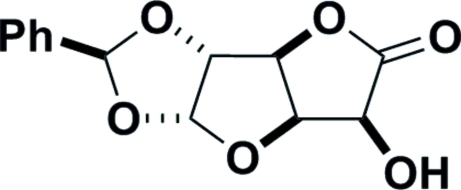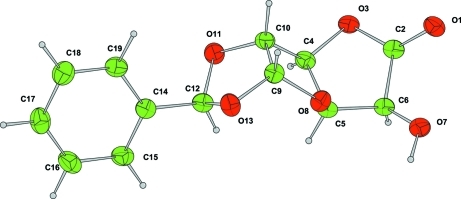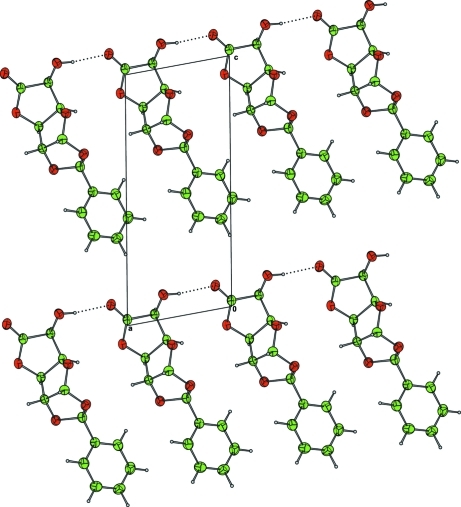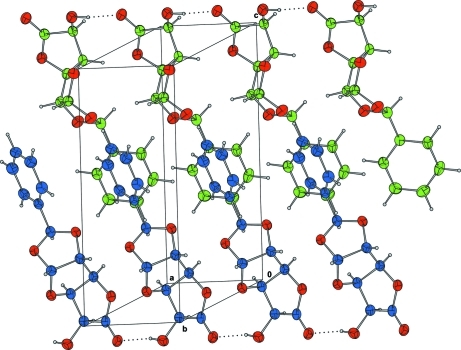Abstract
X-ray crystallographic analysis has established that the major product from the protection of d-glucoronolactone with benzaldehyde is (1S)-1,2-O-benzylidene-α-d-glucurono-6,3-lactone, C13H12O6, rather than the R epimer. The crystal structure exists as O—H⋯O hydrogen-bonded chains of molecules lying parallel to the a axis. The absolute configuration was determined by the use of d-glucuronolactone as the starting material.
Related literature
For related literature on the synthesis of protected d-glucuronolactone, see: Sheldrick et al. (1983 ▶); Macher et al. (1979 ▶); Shah (1969 ▶). For literature related to the use of acetonide-protected d-glucuronolactone as an intermediate in the synthesis of (a) other sugars, see: Bleriot et al. (1997 ▶); Dax et al. (1991 ▶); Ke et al. (2003 ▶); Masaguer et al. (1997 ▶); (b) imino sugars, see: Dax et al. (1990 ▶); (c) sugar amino acids, see: Bashyal et al. (1986 ▶, 1987 ▶); (d) many other bioactive targets, see: Kitahara et al. (1974 ▶); Austin et al. (1987 ▶); Witty et al. (1990 ▶); Shing & Tsui (1992 ▶); Yoda et al. (2002 ▶). For the original NMR studies on benzylidene-protected glucoronolactone, see Csuk et al. (1984 ▶).
Experimental
Crystal data
C13H12O6
M r = 264.23
Monoclinic,

a = 5.6329 (1) Å
b = 7.8943 (2) Å
c = 13.3182 (3) Å
β = 99.9545 (9)°
V = 583.32 (2) Å3
Z = 2
Mo Kα radiation
μ = 0.12 mm−1
T = 150 K
0.60 × 0.50 × 0.30 mm
Data collection
Nonius KappaCCD area-detector diffractometer
Absorption correction: multi-scan (DENZO/SCALEPACK; Otwinowski & Minor, 1997 ▶) T min = 0.88, T max = 0.96
8275 measured reflections
1418 independent reflections
1341 reflections with I > 2σ(I)
R int = 0.022
Refinement
R[F 2 > 2σ(F 2)] = 0.027
wR(F 2) = 0.068
S = 0.96
1418 reflections
172 parameters
1 restraint
H-atom parameters constrained
Δρmax = 0.20 e Å−3
Δρmin = −0.18 e Å−3
Data collection: COLLECT (Nonius, 2001 ▶); cell refinement: DENZO/SCALEPACK (Otwinowski & Minor, 1997 ▶); data reduction: DENZO/SCALEPACK; program(s) used to solve structure: SIR92 (Altomare et al., 1994 ▶); program(s) used to refine structure: CRYSTALS (Betteridge et al., 2003 ▶); molecular graphics: CAMERON (Watkin et al., 1996 ▶); software used to prepare material for publication: CRYSTALS.
Supplementary Material
Crystal structure: contains datablocks global, I. DOI: 10.1107/S1600536809002876/lh2760sup1.cif
Structure factors: contains datablocks I. DOI: 10.1107/S1600536809002876/lh2760Isup2.hkl
Additional supplementary materials: crystallographic information; 3D view; checkCIF report
Table 1. Hydrogen-bond geometry (Å, °).
| D—H⋯A | D—H | H⋯A | D⋯A | D—H⋯A |
|---|---|---|---|---|
| O7—H71⋯O1i | 0.86 | 1.97 | 2.811 (3) | 165 |
Symmetry code: (i)  .
.
Acknowledgments
The authors thank the Oxford University Crystallography Service for use of the instruments.
supplementary crystallographic information
Comment
D-Glucuronolactone 3 (Fig. 1), the only cheaply availably uronic acid, reacts with acetone in the presence of an acid catalyst to form the acetonide 4 (Sheldrick et al., 1983). With only a single unprotected hydroxyl group, the lactone 4 provides convenient access to C-5 of D-glucose and has long been used as a versatile intermediate for the synthesis of other sugars (Bleriot et al., 1997; Dax et al., 1991; Ke et al., 2003; Masaguer et al., 1997), imino sugars (Dax et al., 1990), sugar amino acids (Bashyal et al., 1986, 1987) and many other bioactive targets (Kitahara et al., 1974; Austin et al., 1987; Witty et al., 1990; Shing & Tsui, 1992; Yoda et al., 2002). Reaction of 3 with benzaldehyde in the presence of zinc chloride gives a high yield of the benzylidene protected lactones in which the epimers are formed in a ratio of approximately 5:1 (Macher et al., 1979; Shah, 1969). The configuration of the benzylidene acetal has previously been investigated by NMR experiments which suggest that 1, which is the major product, has the 1,2(S)-configuration (Csuk et al., 1984). The crystallographic analysis confirms that this assignment is correct and that the major product is 1. Although as yet there have been no examples of the use of the benzylidene acetals 1 and 2 as synthetic intermediates, it is likely there will be cases where the use of a benzylidene group, which can be removed by hydrogenation, will have a significant advantage over the acetonide 4, where strong acid must be used to remove the protecting group.
The title compound (Fig. 2) exists as alternating layers of hydrogen bonded chains of molecules lying parallel to the a-axis (Fig. 3, Fig. 4). Only classical hydrogen bonding has been considered. The absolute configuration was determined by the use of D-glucuronolactone as the starting material.
Experimental
The title compound was recrystallized by vapour diffusion from a mixture of ethyl acetate and cyclohexane: m.p. 419.5–421.5 K; [α]D20 +67 (c, 1.0 in acetone) (Macher et al., 1979).
Refinement
In the absence of significant anomalous scattering, Friedel pairs were merged and the absolute configuration was assigned from the starting material.
The H atoms were all located in a difference map, but those attached to C atoms were repositioned geometrically. The H atoms were initially refined with soft restraints on the bond lengths and angles to regularize their geometry (C—H in the range 0.93–0.98, O—H = 0.82 Å) and Uiso(H) (in the range 1.2–1.5 times Ueq of the parent atom), after which the positions were refined with riding constraints.
Figures
Fig. 1.
Synthetic scheme
Fig. 2.
The title compound with displacement ellipsoids drawn at the 50% probability level. H atoms are shown as spheres of arbitary radius.
Fig. 3.
Packing diagram of the title compound projected along the b-axis. Hydrogen bonding is indicated by dotted lines.
Fig. 4.
Packing diagram showing alternating layers of hydrogen bonded chains of molecules.
Crystal data
| C13H12O6 | F(000) = 276 |
| Mr = 264.23 | Dx = 1.504 Mg m−3 |
| Monoclinic, P21 | Mo Kα radiation, λ = 0.71073 Å |
| Hall symbol: P 2yb | Cell parameters from 1368 reflections |
| a = 5.6329 (1) Å | θ = 5–27° |
| b = 7.8943 (2) Å | µ = 0.12 mm−1 |
| c = 13.3182 (3) Å | T = 150 K |
| β = 99.9545 (9)° | Plate, colourless |
| V = 583.32 (2) Å3 | 0.60 × 0.50 × 0.30 mm |
| Z = 2 |
Data collection
| Nonius KappaCCD area-detector diffractometer | 1341 reflections with I > 2σ(I) |
| graphite | Rint = 0.022 |
| ω scans | θmax = 27.5°, θmin = 5.2° |
| Absorption correction: multi-scan (DENZO/SCALEPACK; Otwinowski & Minor, 1997) | h = −7→7 |
| Tmin = 0.88, Tmax = 0.96 | k = −10→10 |
| 8275 measured reflections | l = −17→17 |
| 1418 independent reflections |
Refinement
| Refinement on F2 | Primary atom site location: structure-invariant direct methods |
| Least-squares matrix: full | Hydrogen site location: inferred from neighbouring sites |
| R[F2 > 2σ(F2)] = 0.027 | H-atom parameters constrained |
| wR(F2) = 0.068 | Method = modified Sheldrick w = 1/[σ2(F2) + (0.04P)2 + 0.13P], where P = [max(Fo2,0) + 2Fc2]/3 |
| S = 0.96 | (Δ/σ)max = 0.009 |
| 1418 reflections | Δρmax = 0.20 e Å−3 |
| 172 parameters | Δρmin = −0.18 e Å−3 |
| 1 restraint |
Fractional atomic coordinates and isotropic or equivalent isotropic displacement parameters (Å2)
| x | y | z | Uiso*/Ueq | ||
| O1 | 1.1555 (2) | 0.28908 (18) | 1.09521 (9) | 0.0317 | |
| C2 | 1.0013 (3) | 0.2487 (3) | 1.02461 (12) | 0.0257 | |
| O3 | 1.04981 (19) | 0.2312 (2) | 0.92986 (9) | 0.0296 | |
| C4 | 0.8321 (3) | 0.1868 (2) | 0.85789 (12) | 0.0263 | |
| C5 | 0.6246 (3) | 0.2272 (2) | 0.91452 (12) | 0.0246 | |
| C6 | 0.7382 (3) | 0.2089 (2) | 1.02587 (12) | 0.0259 | |
| O7 | 0.6540 (2) | 0.3147 (2) | 1.09703 (9) | 0.0334 | |
| O8 | 0.5720 (2) | 0.40215 (18) | 0.89088 (9) | 0.0285 | |
| C9 | 0.6089 (3) | 0.4347 (2) | 0.79011 (12) | 0.0265 | |
| C10 | 0.8011 (3) | 0.3081 (2) | 0.76761 (12) | 0.0267 | |
| O11 | 0.6942 (2) | 0.2266 (2) | 0.67619 (9) | 0.0323 | |
| C12 | 0.4413 (3) | 0.2413 (2) | 0.66815 (12) | 0.0269 | |
| O13 | 0.4052 (2) | 0.40025 (19) | 0.71549 (9) | 0.0307 | |
| C14 | 0.3210 (3) | 0.2382 (2) | 0.55862 (12) | 0.0266 | |
| C15 | 0.1004 (3) | 0.1573 (3) | 0.53152 (14) | 0.0320 | |
| C16 | −0.0149 (3) | 0.1563 (3) | 0.43042 (15) | 0.0379 | |
| C17 | 0.0921 (3) | 0.2338 (3) | 0.35636 (14) | 0.0374 | |
| C18 | 0.3143 (3) | 0.3125 (3) | 0.38315 (14) | 0.0368 | |
| C19 | 0.4288 (3) | 0.3166 (3) | 0.48437 (14) | 0.0321 | |
| H41 | 0.8338 | 0.0667 | 0.8363 | 0.0325* | |
| H51 | 0.4805 | 0.1554 | 0.8912 | 0.0314* | |
| H61 | 0.7293 | 0.0846 | 1.0439 | 0.0312* | |
| H91 | 0.6542 | 0.5570 | 0.7843 | 0.0323* | |
| H101 | 0.9551 | 0.3623 | 0.7612 | 0.0324* | |
| H121 | 0.3793 | 0.1500 | 0.7071 | 0.0326* | |
| H151 | 0.0235 | 0.1040 | 0.5830 | 0.0404* | |
| H161 | −0.1724 | 0.1016 | 0.4108 | 0.0448* | |
| H171 | 0.0114 | 0.2344 | 0.2852 | 0.0453* | |
| H181 | 0.3876 | 0.3631 | 0.3302 | 0.0450* | |
| H191 | 0.5853 | 0.3725 | 0.5058 | 0.0382* | |
| H71 | 0.5030 | 0.2905 | 1.0901 | 0.0522* |
Atomic displacement parameters (Å2)
| U11 | U22 | U33 | U12 | U13 | U23 | |
| O1 | 0.0237 (6) | 0.0355 (8) | 0.0344 (6) | 0.0018 (5) | 0.0009 (5) | −0.0001 (5) |
| C2 | 0.0234 (7) | 0.0216 (7) | 0.0319 (8) | 0.0030 (7) | 0.0044 (6) | 0.0031 (7) |
| O3 | 0.0193 (5) | 0.0384 (7) | 0.0316 (6) | 0.0026 (5) | 0.0051 (4) | 0.0001 (6) |
| C4 | 0.0213 (7) | 0.0265 (8) | 0.0306 (8) | 0.0011 (6) | 0.0036 (6) | −0.0021 (7) |
| C5 | 0.0209 (7) | 0.0227 (8) | 0.0306 (8) | −0.0016 (7) | 0.0058 (6) | −0.0001 (7) |
| C6 | 0.0233 (7) | 0.0256 (9) | 0.0295 (8) | −0.0013 (7) | 0.0059 (6) | 0.0014 (7) |
| O7 | 0.0262 (6) | 0.0428 (8) | 0.0325 (6) | −0.0009 (6) | 0.0088 (5) | −0.0056 (6) |
| O8 | 0.0309 (6) | 0.0268 (6) | 0.0286 (6) | 0.0060 (6) | 0.0077 (5) | 0.0009 (5) |
| C9 | 0.0291 (8) | 0.0228 (8) | 0.0276 (8) | 0.0000 (7) | 0.0050 (6) | −0.0006 (6) |
| C10 | 0.0226 (7) | 0.0295 (9) | 0.0286 (8) | −0.0018 (7) | 0.0064 (6) | −0.0018 (7) |
| O11 | 0.0252 (5) | 0.0416 (7) | 0.0302 (6) | 0.0068 (6) | 0.0047 (4) | −0.0076 (6) |
| C12 | 0.0251 (7) | 0.0240 (8) | 0.0319 (8) | 0.0009 (7) | 0.0061 (6) | −0.0012 (7) |
| O13 | 0.0285 (6) | 0.0316 (7) | 0.0305 (6) | 0.0082 (6) | 0.0010 (5) | −0.0051 (5) |
| C14 | 0.0267 (7) | 0.0231 (8) | 0.0302 (8) | 0.0019 (7) | 0.0056 (6) | −0.0024 (7) |
| C15 | 0.0291 (8) | 0.0301 (9) | 0.0380 (9) | −0.0033 (8) | 0.0095 (7) | −0.0071 (8) |
| C16 | 0.0298 (9) | 0.0393 (11) | 0.0432 (11) | −0.0038 (8) | 0.0021 (8) | −0.0154 (9) |
| C17 | 0.0419 (10) | 0.0367 (10) | 0.0319 (8) | 0.0061 (9) | 0.0014 (7) | −0.0079 (9) |
| C18 | 0.0423 (10) | 0.0343 (10) | 0.0344 (9) | 0.0016 (9) | 0.0083 (8) | 0.0017 (8) |
| C19 | 0.0314 (8) | 0.0291 (9) | 0.0363 (9) | −0.0040 (8) | 0.0068 (7) | 0.0011 (8) |
Geometric parameters (Å, °)
| O1—C2 | 1.207 (2) | C10—O11 | 1.416 (2) |
| C2—O3 | 1.344 (2) | C10—H101 | 0.984 |
| C2—C6 | 1.518 (2) | O11—C12 | 1.4148 (19) |
| O3—C4 | 1.4628 (19) | C12—O13 | 1.435 (2) |
| C4—C5 | 1.530 (2) | C12—C14 | 1.499 (2) |
| C4—C10 | 1.524 (2) | C12—H121 | 0.987 |
| C4—H41 | 0.991 | C14—C15 | 1.388 (2) |
| C5—C6 | 1.517 (2) | C14—C19 | 1.392 (3) |
| C5—O8 | 1.436 (2) | C15—C16 | 1.390 (3) |
| C5—H51 | 0.995 | C15—H151 | 0.969 |
| C6—O7 | 1.406 (2) | C16—C17 | 1.384 (3) |
| C6—H61 | 1.014 | C16—H161 | 0.981 |
| O7—H71 | 0.861 | C17—C18 | 1.388 (3) |
| O8—C9 | 1.417 (2) | C17—H171 | 0.977 |
| C9—C10 | 1.540 (2) | C18—C19 | 1.390 (3) |
| C9—O13 | 1.4088 (19) | C18—H181 | 0.963 |
| C9—H91 | 1.005 | C19—H191 | 0.983 |
| O1—C2—O3 | 121.52 (15) | C9—C10—O11 | 104.69 (13) |
| O1—C2—C6 | 128.19 (15) | C4—C10—O11 | 111.49 (15) |
| O3—C2—C6 | 110.28 (13) | C9—C10—H101 | 113.3 |
| C2—O3—C4 | 110.88 (12) | C4—C10—H101 | 111.0 |
| O3—C4—C5 | 104.62 (13) | O11—C10—H101 | 111.9 |
| O3—C4—C10 | 109.58 (14) | C10—O11—C12 | 107.49 (12) |
| C5—C4—C10 | 105.37 (13) | O11—C12—O13 | 104.83 (13) |
| O3—C4—H41 | 111.7 | O11—C12—C14 | 110.64 (13) |
| C5—C4—H41 | 112.9 | O13—C12—C14 | 111.54 (15) |
| C10—C4—H41 | 112.2 | O11—C12—H121 | 110.1 |
| C4—C5—C6 | 103.48 (12) | O13—C12—H121 | 108.5 |
| C4—C5—O8 | 103.80 (13) | C14—C12—H121 | 111.0 |
| C6—C5—O8 | 109.98 (14) | C12—O13—C9 | 108.59 (12) |
| C4—C5—H51 | 112.3 | C12—C14—C15 | 119.63 (16) |
| C6—C5—H51 | 115.8 | C12—C14—C19 | 120.33 (15) |
| O8—C5—H51 | 110.7 | C15—C14—C19 | 120.04 (16) |
| C2—C6—C5 | 102.55 (12) | C14—C15—C16 | 120.10 (18) |
| C2—C6—O7 | 109.20 (14) | C14—C15—H151 | 120.4 |
| C5—C6—O7 | 117.93 (14) | C16—C15—H151 | 119.5 |
| C2—C6—H61 | 106.9 | C15—C16—C17 | 119.99 (17) |
| C5—C6—H61 | 107.1 | C15—C16—H161 | 120.7 |
| O7—C6—H61 | 112.2 | C17—C16—H161 | 119.3 |
| C6—O7—H71 | 103.8 | C16—C17—C18 | 119.95 (17) |
| C5—O8—C9 | 108.88 (13) | C16—C17—H171 | 120.4 |
| O8—C9—C10 | 106.84 (14) | C18—C17—H171 | 119.6 |
| O8—C9—O13 | 113.45 (14) | C17—C18—C19 | 120.40 (18) |
| C10—C9—O13 | 104.58 (13) | C17—C18—H181 | 118.6 |
| O8—C9—H91 | 109.2 | C19—C18—H181 | 121.0 |
| C10—C9—H91 | 114.3 | C14—C19—C18 | 119.51 (17) |
| O13—C9—H91 | 108.5 | C14—C19—H191 | 118.2 |
| C9—C10—C4 | 104.06 (13) | C18—C19—H191 | 122.3 |
Hydrogen-bond geometry (Å, °)
| D—H···A | D—H | H···A | D···A | D—H···A |
| C4—H41···O1i | 0.99 | 2.37 | 3.200 (3) | 141 |
| C6—H61···O8ii | 1.01 | 2.49 | 3.289 (3) | 135 |
| C9—H91···O1iii | 1.01 | 2.55 | 3.349 (3) | 137 |
| C15—H151···O11iv | 0.97 | 2.59 | 3.281 (3) | 128 |
| C16—H161···O13v | 0.98 | 2.51 | 3.350 (3) | 143 |
| O7—H71···O1iv | 0.86 | 1.97 | 2.811 (3) | 165 |
Symmetry codes: (i) −x+2, y−1/2, −z+2; (ii) −x+1, y−1/2, −z+2; (iii) −x+2, y+1/2, −z+2; (iv) x−1, y, z; (v) −x, y−1/2, −z+1.
Footnotes
Supplementary data and figures for this paper are available from the IUCr electronic archives (Reference: LH2760).
References
- Altomare, A., Cascarano, G., Giacovazzo, C., Guagliardi, A., Burla, M. C., Polidori, G. & Camalli, M. (1994). J. Appl. Cryst.27, 435.
- Austin, G. N., Fleet, G. W. J., Peach, J. M., Prout, K. & Son, J. C. (1987). Tetrahedron Lett.28, 4741–4744.
- Bashyal, B. P., Chow, H. F., Fellows, L. E. & Fleet, G. W. J. (1987). Tetrahedron, 43, 415–422.
- Bashyal, B. P., Chow, H. F. & Fleet, G. W. J. (1986). Tetrahedron Lett.27, 3205–3208.
- Betteridge, P. W., Carruthers, J. R., Cooper, R. I., Prout, K. & Watkin, D. J. (2003). J. Appl. Cryst.36, 1487.
- Bleriot, Y., Masaguer, C. F., Charlwood, J., Winchester, B. G., Lane, A. L., Crook, S., Watkin, D. J. & Fleet, G. W. J. (1997). Tetrahedron, 53, 15135–15146.
- Csuk, R., Mueller, N. & Weidmann, H. (1984). Monatsh. Chem.115, 93–99.
- Dax, K., Fechter, M., Gradnig, G., Grassberger, V., Illaszewicz, C., Ungerank, M. V. & Stuetz, A. E. D (1991). Carbohydr. Res.217, 59–70.
- Dax, K., Gaigg, B., Grassberger, B., Koelblinger, B. & Stuetz, A. E. (1990). J. Carbohydr. Chem.9, 479–99.
- Ke, W., Whitfield, D. M., Gill, M., Larocque, S. & Yu, S.-H. (2003). Tetrahedron Lett.44, 7767–7770.
- Kitahara, T., Ogawa, T., Naganuma, T. & Matsui, M. (1974). Agric. Biol. Chem.38, 2189–90.
- Macher, I., Dax, K., Inselsbacher, H. & Weidmann, H. (1979). Carbohydr. Res.77, 225–230.
- Masaguer, C. F., Bleriot, Y., Charlwood, J., Winchester, B. G. & Fleet, G. W. J. (1997). Tetrahedron, 53, 15147–15156.
- Nonius (2001). COLLECT Nonius BV, Delft, The Netherlands.
- Otwinowski, Z. & Minor, W. (1997). Methods in Enzymology, Vol. 276, Macromolecular Crystallography, Part A, edited by C. W. Carter Jr & R. M. Sweet, pp. 307–326. New York: Academic Press.
- Shah, R. H. (1970). Carbohydr. Res.12, 43–56.
- Sheldrick, B., Mackie, W. & Akrigg, D. (1983). Acta Cryst. C39, 1257–1259.
- Shing, T. K. M. & Tsui, H. C. (1992). J. Chem. Soc. Chem. Commun. pp. 432–434.
- Watkin, D. J., Prout, C. K. & Pearce, L. J. (1996). CAMERON Chemical Crystallography Laboratory, Oxford, England.
- Witty, D. R., Fleet, G. W. J., Vogt, K., Wilson, F. X., Wang, Y., Storer, R., Myers, P. L. & Wallis, C. J. (1990). Tetrahedron Lett.33, 4787–4790.
- Yoda, H., Nakaseko, Y. & Takabe, K. (2002). Synlett, pp. 1532–1534.
Associated Data
This section collects any data citations, data availability statements, or supplementary materials included in this article.
Supplementary Materials
Crystal structure: contains datablocks global, I. DOI: 10.1107/S1600536809002876/lh2760sup1.cif
Structure factors: contains datablocks I. DOI: 10.1107/S1600536809002876/lh2760Isup2.hkl
Additional supplementary materials: crystallographic information; 3D view; checkCIF report






